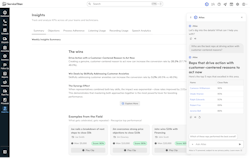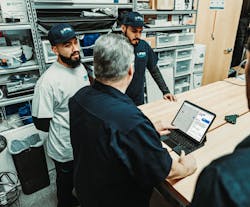Smarter, Faster, Stronger: How Artificial Intelligence is Changing the Game for Contractors
Key Highlights
- AI tools help HVACR contractors save time, reduce costs, and improve customer service through smarter dispatching and communication strategies.
- Successful AI integration depends on proper data management, clear problem-solving focus, and thoughtful change management to overcome cultural and technical challenges.
- Humanizing AI by giving virtual agents names and personalities fosters better team cohesion and enhances customer interactions.
Artificial intelligence is no longer a futuristic concept — it’s quickly becoming a practical tool in the HVACR industry. From streamlining dispatch operations to improving call center accuracy and bookings to coaching techs on virtual ride alongs, contractors are discovering how AI can save time, cut costs, and deliver better service to customers.
For HVACR contractors, the value of AI isn’t about replacing people — it’s about empowering them. Smart dispatching platforms are helping companies optimize routes and reduce wasted time, while also improving pricing strategies, forecasting demand, and even enhancing customer communication. The result is a stronger, more agile operation that allows contractors to focus on what they do best: delivering comfort and reliability.
According to a report from Housecall Pro earlier this year surveying over 400 home service contractors across the country, over 70% have tried AI tools in some capacity, and about 40% are now using AI actively in their businesses. According to the report, 54% of business owners under 35 are already using AI to automate parts of their operations, roughly twice the rate of those over 65. Notably, AI adoption is consistent across business sizes — small shops are embracing AI nearly as much as large ones.
“Contractors said AI helped them save about 4.2 hours a week, on average, across everything we did,” says Roland Ligtenberg, Housecall Pro co-founder and senior vice president of innovation and growth. “Over half of them credited AI with some of their business growth.”
Ligtenberg stresses that AI is not a replacement for the skilled trades. “I love to describe it as our HVAC pros have standing jobs. AI is really great at sitting jobs. It’s super beneficial in that it frees up time for our pros to focus on those things that are truly difficult.”
Patrick Johnson, head of contractor experience at Rilla, points to the increased private equity investment in the industry making the skilled trades more mainstream. And, because of this, many new products are being tailor-made for trade pros.
“At this point, AI has fully penetrated,” he notes. “Contractors understand that it’s something that can give them a competitive edge. If you have a tool you can optimize, let’s say dispatch like ProBook does, or coach your team a hundred times faster, like Rilla — there’s a sense that if you’re not using it, you're letting an opportunity pass. Especially in such a competitive space like HVAC, if you’re not using it, your competition probably is.”
Vincent Payen, senior vice president and general manager of Pro Products at ServiceTitan, agrees that it’s a fascinating time to be in the trades.
“It reminds me a little bit of Ford assembly lines as a moment that fundamentally transformed the industry because we are seeing HVAC businesses transform how they operate nearly in real time,” Payen explains. “Every week, we see businesses automate something new, putting together AI solutions to achieve, in some cases, end-to-end automation. On ServiceTitan, we see some contractors who are automating full jobs end-to-end, from the marketing campaign creation, the customer support piece — like booking, dispatching, etc. — where effectively, besides in the field, no human intervenes in the process. Even just a year ago, that was not really thinkable, or at least not with the level of quality that we're seeing happen today.”
The pace of innovation is incredible, Payen adds, especially with how contractors have been able to leverage the technology for their businesses. “Historically, the trades have been late in adopting technology, and we're absolutely seeing the trades being at the forefront of what AI can do because the applications are so practical and so powerful given the challenges that these businesses have to operate.”
Investment versus ROI
Rocky Ozaki, founder and CEO of The NoW of Work, has worked with many home services contractors on developing the right framework to adopt AI solutions into their businesses. There’s always a cost involved, but if contractors don’t consider the proper use cases or create buy-in with their team, the cost of failure could be infinitely more expensive.
“Some subscriptions could cost contractors tens of thousands a year,” Ozaki says. “That’s potentially out of the range for some businesses. This is why framework is important. If you start with a problem to solve, and that problem ends up costing $40,000 a year with an AI solution, if it’s your biggest problem that can turn your bottom line around by a quarter of a million dollars, is $40,000 really a lot of money? No, because the ROI is there.”
On the other hand, if a contractor adopts a blanket AI tool that everyone is using for $40,000, and only gets a $20,000 improvement, the company never should have been using it in the first place, he adds.
“One thing to note is we’re not always calculating ROI the same way as we traditionally do,” Ozaki says. “If you don’t join this AI train, you’re going to lose staff. If you're trying to hire top talent, which I think most of us try to do, what happens when there's a team member or a potential candidate who has the option to work at your company — that is not on the AI train — or another company that is experimenting with AI, learning it, and growing with it? Where do you think that talent is going to go? That’s part of the ROI piece, too. Can we afford to do it financially, and secondly, can you afford not to if we believe we’re in a talent crisis? Top talent wants to be upskilled on it, that’s return on investment, to me.”
According to Payen, some contractors love experimenting and trying new things, but not every business should start at the same place.
“The journey is very personal to these businesses,” he says. “If used well, in every part of the funnel, every part of the business has a story of AI being able to unlock ROI. But how do you do it? How do you do it while preserving who you are as a company? The No. 1 thing is for AI to be efficient and powerful. It needs data and context because the capabilities an AI solution may have can be very different in real life when applied to a business. If this AI doesn't have the right integration and context, it will not be able to make the right decisions.”
While the number of different AI solutions in the marketplace is multiplying, which is exciting, Payen notes, it can also lead to danger and confusion. “You can end up with a mismatch of five AI solutions in different points in the business that don’t talk to each other, don’t have context about what each one is doing, and you actually end up with an outcome that could be worse than what you’re doing today.”
Humanizing Technology
Payen stresses that being thoughtful about AI adoption and translating the essence of who the company is in a highly automated AI-powered operating model is really important.
“Otherwise, it's not going to feel good and pleasant,” he says.
A good example of this is the virtual agents and chatbots who answer the phone and book jobs — some companies are giving them a name.
“It’s interesting that it’s the first thing they do,” Payen says. “They’re investing in a machine automation product, and the first thing they do is give it a name so it’s more like a human. They actually talk about it like it’s a human. ‘Oh, Max handles that.’ And it’s amazing because the AI becomes part of the team, it’s not just a computer doing something.”
Rancho Cordova, California-based Bonney Plumbing, Electrical, Heating & Air has dubbed its virtual AI agent as “Sarah.”
“We have an initiative across the company to really lean into AI where we can and where it makes sense,” says Angela Kump, junior system administrator at Bonney. “We are using ServiceTitan Contact Center Pro Voice agents, but also things like Gemini from Google, and Google’s Notebook LM to create internal chatbots for ourselves. We’ve uploaded and connected our own knowledge base sources so our employees can interact and ask questions of these different notebooks like they would any other person and get a response. We kicked off the initiative last year, and when we found out these virtual agents were going to be part of it, we got super excited. The virtual agents have allowed us to flex our call center more than we were able to do before.”
Previously, Bonney used an answering service to handle overflow and after-hours calls, but those agents didn’t necessarily handle the calls the way Bonney would have liked.
“Answering services don’t have the same investment in your business as your actual CSRs do,” Kump says. “Using Contact Center Pro, we've really seen those virtual agents handle the call the same way every time. They're not going to have a bad day where they don't handle the customer in the way you would expect. The AI virtual agent came with a basic name, I think it was Sam. From day one during onboarding, we wanted to give it a different name. Sam didn’t sound like what we wanted her to sound like, but Sarah was a great human-sounding name that wouldn’t be off-putting for our customers. Internally, it’s so much easier for it to have a human name — she’s just another person on the team.”
Bonney has three sister companies, and each has its own virtual agent.
“Instead of reusing Sarah across the board for all four companies, we gave them each their own name,” Kump explains. “Sarah came first, then we added Alana, Nora, and Ivy. They are all female voices, so we went with female names — something that wouldn’t be too out of the norm. We came up with Sarah on the spot ourselves, but for the others, we actually turned to ChatGPT and gave it specifications for the location of the company and the general feeling we wanted the name to have. So yes, we used AI to name our AI.”
Sila Services, a home services platform featuring over 40 brands and more than 2,500 employees, has been leaning into AI in a very intentional way, according to Eddie McFarlane, vice president of training, development, and engagement.
“At Sila, we don’t look at AI as a replacement for people — we see it as an accelerator,” he says. “We have a pilot program where after training we use an virtual buddy AI that helps us review technician ride-alongs and call recordings to give faster, more actionable feedback. Instead of waiting weeks for a manager to catch an issue, AI can flag patterns in real time. We’re also pretty far into rolling out AI to support call center agents. We have used AI for after-hours and overflow. And I use it for internal productivity — I’ve built a personal AI assistant, tongue-in-cheek named “Eddie’s Little Helper.” It organizes emails, pulls out tasks, and keeps me on top of priorities. A few of our managers are experimenting with similar tools.”
While Sila hasn’t gone as far as to name its enterprise pilots yet, McFarlane notes he recognizes that humanizing AI makes it less intimidating for teams, and it’s something Sila eventually plans to do. “For now, we’re more focused on testing and using AI in ways that support technicians, salespeople, and managers without disrupting trust.”
Scott Sharrock, COO of Jolly Plumbing, Drains, Heating & Air, also notes that while the company is using AI across several business areas to improve efficiency, customer experience, and training, it also has not given the technology a name.
“We use Avoca to answer all calls outside our normal business hours, including weekends and holidays,” he says. “It integrates directly with ServiceTitan, automatically booking jobs to our dispatch board with complete customer and job details. The name that Avoca uses is Sara. For now, we see AI as a set of tools that make our team more effective and allow us to focus on what matters most: serving customers. One of our core values is ‘Here to Serve.’”
Jolly also uses Probook for dispatching, Chiirp for customer communication, and ChatGPT for internal training.
“Probook uses performance data on each technician and job type to ensure the right tech is sent to the right job,” Sharrock says. “It factors in a metric we call “dollars per door knock” and even optimizes dispatching when similar job types are nearby. While efficiency matters, our main priority is always matching the best technician to the right customer need. Chiirp helps us maximize our customer database. We use it for outbound campaigns such as scheduling system checks for current members, offering promotions to non-members, and running personalized text, phone, and chat campaigns. And, internally, we use ChatGPT to support leadership and training development. All of our trainings follow a set formula (opener, content, skill practice/group discussion, action items). AI helps us refine outlines, strengthen content, and break through obstacles like specific objections or skill gaps.”
Adoption Challenges
Johnson used to work as a customer success manager for Rilla, and in that role, helped onboard hundreds of HVACR and plumbing contractors onto the platform.
“The difference between good and great results is going to be how they view the AI working for them,” he says. “Some contractors live with the assumption that the AI is just going to do everything for them. All of these tools are here to augment, improve, and make you more productive. We cannot replace you.”
According to Ligtenberg, the biggest hurdle for contractors is connecting all the tools and data sources because they all live in different places.
“AI is only has good as the data it has,” he explains. “A lot of people have various service-level conversations with AI without giving it all of the context it needs to produce a very good output. The wrong way to adopt a new AI solution is to think that it’s a magic bullet for all your problems. Remember, garbage in, garbage out. I like to describe AI as a really smart 12th grader right now. It's getting smarter, but it’s still in high school — it makes stupid decisions, it doesn’t want to do things right. You still have to have a human in the loop to verify and give it feedback. You’ve got to give it the right data sources. A lot of the stuff we do at Housecall Pro is just around how do we make sure that our AI team members have as many data sources as they can so they can be as smart as they can.”
Ozaki’s tagline is “AI adoption is broken.”
“I always talk about shiny object syndrome — just doing what everyone else does,” he says. “The mistake there is that AI has to be anchored to what problem you are trying to solve. Every contractor is different. Another one is they don’t consider the cultural factor of AI adoption. More studies show that it’s not the technology that’s hard to implement in the organization, it’s the change management. That’s why, in our program, we always start with a survey of how the staff feels about AI. Do they think it’s Terminator level? Are they excited about it? In a legacy industry like home services, if 80% of your team is uncertain about this technology or don't even know what it is, and is afraid of it, one of the biggest mistakes the contractor can make is forcing it on them versus saying here’s a tool we’re going to experiment with, and getting people to opt in. These are humans that we're talking about, and you've got to really be empathetic to their journey.”
Embrace the New Normal
Looking into the future, as AI becomes commonplace, it will fall into the same category of just another tool, much like an anemometer or vacuum pump, Johnson says. “It might be the most important tool, because it touches all parts of the business. I would recommend to all managers, technicians, sales reps, etc., become AI literate. Because managers are going to have to learn how to prompt engineer. They're going to have to learn how to program AI agents to assist with tasks and workflows because there is such a potential time and money savings benefit.”
AI is going to change every aspect of operations for home service companies, Ozaki says. “What history tells us is that emerging technologies generally scale together. There was a time when cell phones came out, and with it, true 3G-type high internet speed and social media. These are three profound technologies. Social media alone wasn’t going to change the world if you didn’t have a phone, because most young people aren’t sitting on a desktop every day. And if you had a phone and maybe social media, but everything was dial-up internet, would it have been as powerful? No. When you put those together, it changed. In two to three years, we’re going to start to see more spatial computing, robotics, and, of course, AI. We’re going to see even faster quantum computing to some degree. They’re all going to rise together.”
According to Payne, the businesses that embrace AI will be absolutely transformed — able to be more efficient, more profitable, and grow faster.
“Be open to rethinking how your business functions, but stay true to who you are and what has made you successful,” he says. “How businesses take care of their customers, how it connects with them, is very important to preserve. The biggest risk everyone has with AI is that everyone sounds the same because everyone has the same AI enterprise service. Choosing an AI solution that will be customizable will be important. It also means using AI in a way that's personal and that's thoughtful.”
AI is going to run the office of an HVAC business, Ligtenberg says. “It’s going to be doing the marketing, adjusting ad spend by channel, season, and campaign type. All of the virtual customer interactions and answering the phones will be AI first. I think a lot of companies will have a hybrid approach, where if someone still wants to talk to a human, it will roll over to a human. And that’s the right way that human and AI interaction should happen. It shouldn’t be all AI or no AI.”
Ligtenberg adds that contractors should start now — don’t wait for it to be perfect.
“Let’s start building momentum both internally with your team members and just with yourself. Data shows that 82% of contractors who tried AI said it met or exceeded their expectations. Treat AI like an apprentice. It will learn as you use it.”
About the Author

Nicole Krawcke
Nicole Krawcke is the Editor-in-Chief of Contracting Business magazine. With over 10 years of B2B media experience across HVAC, plumbing, and mechanical markets, she has expertise in content creation, digital strategies, and project management. Nicole has more than 15 years of writing and editing experience and holds a bachelor’s degree in Journalism from Michigan State University.




